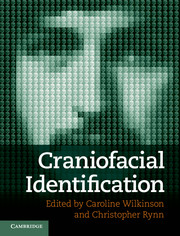Book contents
- Frontmatter
- Contents
- Contributors
- Part I Identification of the Living
- Chapter 1 Familiar face recognition
- Chapter 2 Unfamiliar face recognition
- Chapter 3 EFIT-V
- Chapter 4 Facial recall and computer composites
- Chapter 5 Facial ageing
- Chapter 6 Age progression and regression
- Chapter 7 Computer-assisted age progression
- Chapter 8 Facial recognition from identification parades
- Chapter 9 Virtual human identification line-ups
- Chapter 10 Computer-generated face models
- Chapter 11 Recognising and learning faces in motion
- Chapter 12 Facial image comparison
- Chapter 13 Three-dimensional facial imaging
- Part II Identification of the Dead
- Index
- Plate Section
- References
Chapter 1 - Familiar face recognition
Published online by Cambridge University Press: 05 May 2012
- Frontmatter
- Contents
- Contributors
- Part I Identification of the Living
- Chapter 1 Familiar face recognition
- Chapter 2 Unfamiliar face recognition
- Chapter 3 EFIT-V
- Chapter 4 Facial recall and computer composites
- Chapter 5 Facial ageing
- Chapter 6 Age progression and regression
- Chapter 7 Computer-assisted age progression
- Chapter 8 Facial recognition from identification parades
- Chapter 9 Virtual human identification line-ups
- Chapter 10 Computer-generated face models
- Chapter 11 Recognising and learning faces in motion
- Chapter 12 Facial image comparison
- Chapter 13 Three-dimensional facial imaging
- Part II Identification of the Dead
- Index
- Plate Section
- References
Summary
Introduction
The task of the police officer investigating a crime, or of the forensic anthropologist working with human remains, is to establish an identity of a criminal or of a victim. This often involves working with images of faces – building a composite image from the memory of a witness to the crime, seeking CCTV images of the person or persons who might have committed the crime, or building a model of the face of an unknown person from their skull. Many of the chapters in this volume describe the processes involved in such reconstructions.
Once an image of a face is obtained, however, it needs to be identified. TV programmes such as Crimewatch in the UK (see www.bbc.co.uk/crimewatch) often display witness-generated facial composites or CCTV images of people associated with crimes which sometimes result in people volunteering new information; Richard Neave’s constructed image of the unidentified victim 115 of the London Underground tube station fire at Kings Cross in 1987 (Chambers 2007) was displayed widely in newspapers and posters. CCTV images of the London ‘nail bomber’ in 1999 led to hundreds of responses, including one phone call from a man who named a work colleague, David Copeland, as resembling the images. This crucial lead quickly led to the arrest of David Copeland, unfortunately not soon enough to prevent the third devastating bomb attack on The Admiral Duncan, a London pub.
- Type
- Chapter
- Information
- Craniofacial Identification , pp. 1 - 10Publisher: Cambridge University PressPrint publication year: 2012
References
- 1
- Cited by



